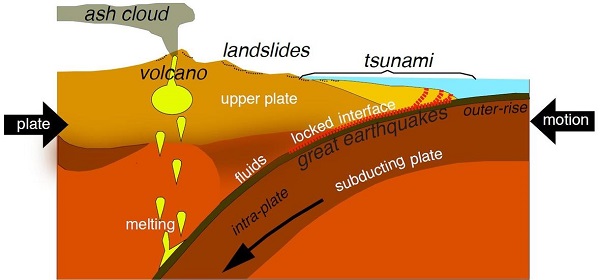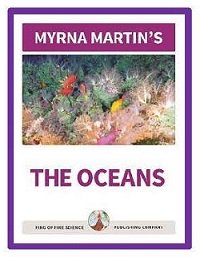Subduction Zones in the pacific ocean
Convergent BOUNDARIES
What are convergent boundaries?
Subduction zones are convergent boundaries where at least one of the tectonic plates is an oceanic crust. The new oceanic crust that forms in spreading centers is recycled in these zones.
Subducting oceanic plate
The oceanic crust melts as it descends into the lithosphere and upper mantle. Subducting plates ring the Pacific Ocean creating volcanic arcs and megathrust earthquakes

Coastal area where an ocean plate is subducting beneath a continental plate. USGS
Converging Oceanic plate and continental plate
Converging crustal plates
Subduction areas develop when a continental crust converges with an oceanic crust. The heavier oceanic crust bends and begins moving downward toward the upper mantle. Recent studies indicate that the subducting plate is pulled downward by gravity.
Oceanic plate begins to melt
The water soaked leading edge of the plate begins melting as it moves deeper into the Earth until it is recycled in the upper mantle. Molten rock collects in magma chambers of the overriding plate. The magma, molten rock, is lighter and less dense than the surrounding rock so it is buoyant. The magma feeds the volcanoes that form in subduction zones.


Click for More Information and to Order
Formation of Volcanic arcs
Volcanic arcs form
A volcanic arc of stratovolcanoes forms on the overriding plate. Stratovolcanoes do not erupt as frequently as shield volcanoes that form over hot spots. The two largest volcanic eruptions of the 20th century were stratovolcanoes in subduction zones in the Pacific Ocean.
Converging oceanic plates
Two oceanic plate converge
If two oceanic plates converge the heavier and denser of the two plates subducts into the upper mantle. The Aleutian Islands in Alaska have formed as the Pacific Plate subducts beneath the North American Plate.
Great earthquakes in subduction zones
Megathrust earthquakes
Great megathrust earthquakes that create tsunamis are associated where subduction of plates take place. As the subducting plate moves beneath the overriding plate they become locked. Pressure builds until the rocks fracture along the fault line.
Oceanic fault lines
In these zones the fault lines are hundreds of miles long. The 9.5 Chilean earthquake and the 9.2 Alaskan earthquake were both subduction megathrust earthquakes. Generally only very large megathrust earthquakes produce tsunamis.
KIDS FUN Science Bookstore
Check out Myrna Martin's award winning textbooks, e-books, videos and rock sets. The Kids Fun Science Bookstore covers a wide range of earth science topics. Click here to browse.










